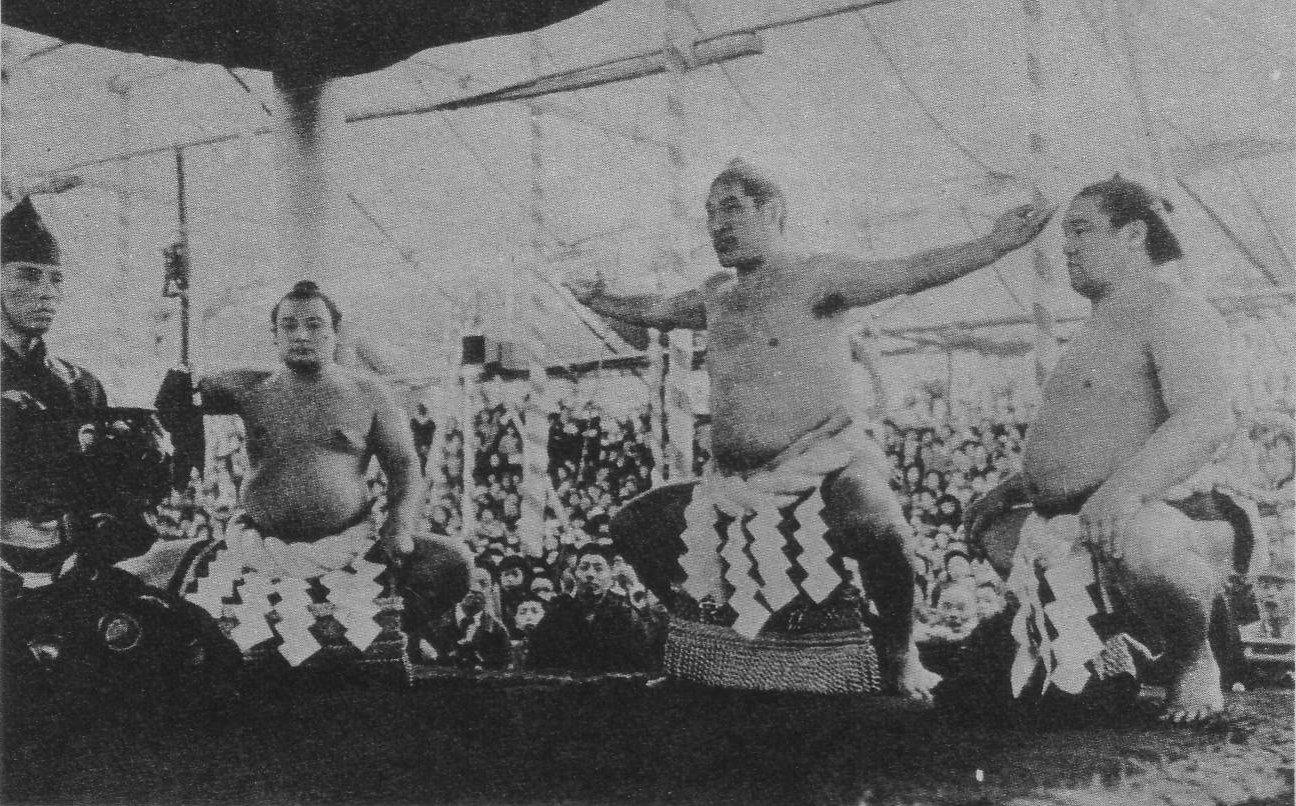Tachimochi on:
[Wikipedia]
[Google]
[Amazon]
 In professional
In professional
sumo
is a form of competitive full-contact wrestling where a ''rikishi'' (wrestler) attempts to force his opponent out of a circular ring (''dohyō'') or into touching the ground with any body part other than the soles of his feet (usually by thr ...
, the ''tachimochi'' (太刀持ち; lit.: sword carrier) is one of the two attendants that accompany a ''yokozuna
, or , is the top division of the six divisions of professional sumo. Its size is fixed at 42 wrestlers (''rikishi''), ordered into five ranks according to their ability as defined by their performance in previous tournaments.
This is the on ...
'' when he performs his ''dohyō-iri
The following words are terms used in sumo wrestling in Japan.
A
B
C
D
E
F
G
H
...
'', or ring entrance ceremony. The other attendant is called the ''tsuyuharai
In professional sumo, the ''tsuyuharai'' (Japanese: 露払い, literally "dew sweeper") is one of the two attendants that accompany a ''yokozuna'' when he performs his '' dohyō-iri'' or ring entrance ceremony. The other attendant is called the ...
''.
During the ceremony the ''tachimochi'' will follow the ''yokozuna'', carrying his sword
A sword is an edged, bladed weapon intended for manual cutting or thrusting. Its blade, longer than a knife or dagger, is attached to a hilt and can be straight or curved. A thrusting sword tends to have a straighter blade with a pointed ti ...
in his right hand, to the ring and squat on his right hand side. The ''yokozunas sword is a traditional indication of his samurai
were the hereditary military nobility and officer caste of medieval and early-modern Japan from the late 12th century until their abolition in 1876. They were the well-paid retainers of the '' daimyo'' (the great feudal landholders). They h ...
status. After the ''yokozuna'' has completed his ceremonial dance the ''tachimochi'' will once again follow him off the ''dohyō''.
The ''tachimochi'' must be a ''makuuchi
, or , is the top division of the six divisions of professional sumo. Its size is fixed at 42 wrestlers (''rikishi''), ordered into five ranks according to their ability as defined by their performance in previous tournaments.
This is the on ...
'' ranked sumo wrestler (or ''rikishi
A , or, more colloquially, , is a professional sumo wrestler. follow and live by the centuries-old rules of the sumo profession, with most coming from Japan, the only country where sumo is practiced professionally. Participation in official t ...
'') and is, if possible, from the same training stable (or ''heya'') as the ''yokozuna''. If there are no appropriate choices from within the stable then the ''tachimochi'' will normally be from another related stable (from the same stable grouping called an ''ichimon
The following words are terms used in sumo wrestling in Japan.
A
B
C
D
E
F
G
H
...
''). The ''tachimochi'' is always the higher ranked wrestler of the two attendants.
All three wrestlers will wear a matching set of ''keshō-mawashi
In sumo, a is the loincloth that (sumo wrestlers) wear during training or in competition. Upper ranked professional wrestlers wear a as part of the ring entry ceremony or .
For top ranked professional , it is made of silk and comes in a va ...
'' belonging to the ''yokozuna'' during the ceremony, and as the ceremony is directly after the ring entry ceremony for the ''makuuchi'' division wrestlers on a tournament day this means that the ''tachimochi'' will also wear the ''yokozunas ''keshō-mawashi'' for his own entrance.
A wrestler who is scheduled to fight the ''yokozuna'' on a particular day of a ''honbasho
A is an official professional sumo tournament. The number of ''honbasho'' every year has varied along the years; since 1958 there are six tournaments every year. Only ''honbasho'' results matter in determining promotion and relegation for ''riki ...
'' (or tournament) will not act as his ''tachimochi''.
In normal circumstances, the ''tachimochi'' will not be another ''yokozuna'' or an '' ōzeki''. An ''ōzeki'' can act as a ''tachimochi'' during a wrestler's very first ''dohyō-iri'', held at Meiji Shrine
, is a Shinto shrine in Shibuya, Tokyo, that is dedicated to the deified spirits of Emperor Meiji and his wife, Empress Shōken. The shrine does not contain the emperor's grave, which is located at Fushimi-momoyama, south of Kyoto.
History
Af ...
in Tokyo
Tokyo (; ja, 東京, , ), officially the Tokyo Metropolis ( ja, 東京都, label=none, ), is the capital and largest city of Japan. Formerly known as Edo, its metropolitan area () is the most populous in the world, with an estimated 37.468 ...
. A ''yokozuna'' will only usually fulfil this role at another ''yokozunas retirement ceremony, or at a special event after the other ''yokozuna'' has announced his retirement, but before the final ceremony.
References
{{Reflist Sumo terminology